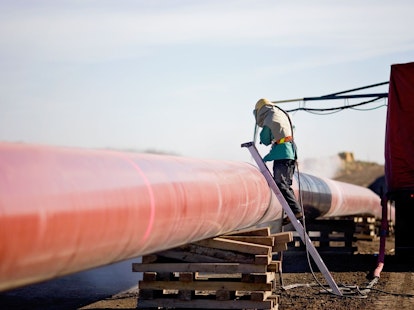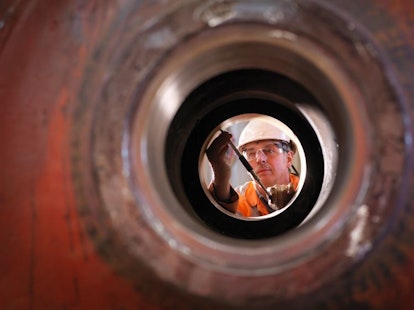In response to global initiatives aimed at curbing dangerous gas emissions, industries have heightened efforts to comply with stringent environmental standards while prioritizing functional safety. This presents a challenge: the utilization of gases critical for production, albeit potentially harmful to the environment. The quest now is to establish a leak-tight method that ensures minimal gas leakage into the environment.
NDT to identify Helium Leak
International quality standards and legislation mandate the use of Helium for conducting leak tests due to its unparalleled ability to deliver reliable, quantifiable, and consistently monitored results.
Helium leak testing stands as a non-destructive method specifically designed to detect and quantify leaks or leakage levels in various systems or components. Helium's selection as a tracer gas is attributed to its inert, non-toxic nature and extremely low atmospheric presence (approximately 5 ppm). Its atomic size, being the smallest after hydrogen, further enhances its suitability for leak detection purposes.
The applications of leak testing span across numerous industries operating within pressure/vacuum boundaries, including nuclear, thermal, chemical, automotive, and vacuum industries. Unlike other non-destructive testing (NDT) methods such as radiography or ultrasonic testing, leak testing is implemented on final products to ensure structural integrity.
However, the complexity arises from the diverse industry requirements necessitating various leak testing techniques. Thus, understanding industry needs, available testing methods, and precise implementation becomes crucial.
The ultimate objective of leak testing is to guarantee the reliability and serviceability of components, preventing premature failure of systems containing fluids under pressure or vacuum.
Applications of Helium Leak Testing
- Oil & Gas, Chemical, Processing, Fertilizer: Ensuring leak tightness in critical products used to process hazardous or special gases, minimizing environmental emissions while maximizing cost-effectiveness. These products encompass piping, vessels, reactors, heat exchangers, valves, and more handling such substances
- Automotive Industry: Ensuring the integrity of automotive components such as fuel tanks, air conditioning systems, and brake systems
- Aerospace and Aviation: Critical for ensuring the reliability of spacecraft, aircraft, and related components
- HVAC Systems: Verifying the sealing of heat exchangers, refrigeration systems, and pipelines
- Medical Devices: Critical for maintaining the integrity of medical equipment like MRI machines, crucial for functionality
- Electronics: Ensuring the integrity of hermetically sealed components like semiconductors, microelectronics, and MEMS
- Power Generation: Preventing radioactive leaks in nuclear power plant components and ensuring the integrity of steam turbine systems
- Pharmaceutical Industry: Ensuring gas containment in pharmaceutical production processes
Techniques Used
- Sniffing Method: external introduction of helium with a sniffer probe detecting escaping helium from leaks
- Vacuum Testing: helium introduction into a vacuum chamber detecting its presence to indicate leaks sometime helium environment are made outside the component whereas component is kept under vacuum and connected with leak detector
- Tracer Gas Accumulation: helium introduced into a sealed enclosure with a mass spectrometer detecting increased helium concentration due to the leaks
Benefits
- Sensitivity: Detects extremely small leaks with high accuracy
- Speed: Efficiently locates leaks
- Non-Destructive: Preserves the integrity of tested equipment and components
Challenges
- Cost: Helium is expensive
- Equipment Complexity: Specialized equipment and trained personnel required
- Environmental Concerns: Helium's finite nature raises environmental and cost concerns
In critical industries emphasizing safety and reliability, helium leak testing remains indispensable, ensuring product integrity while averting potential hazards from leaks in diverse systems and components.
How SGS can help
At SGS, a pioneering Testing, Inspection, and Certification (TIC) provider, we offer comprehensive support in the realm of Non-Destructive Testing (NDT) across a spectrum of activities.
Documentation Support:
- Collaborating with you to craft NDT specifications and procedures tailored to your requirements
- Thorough review and approval of procedures to ensure compliance and quality
- Conducting NDT audits on your projects to verify adherence to specifications, ensuring that tests, procedures, reports, and records align with project requirements. This serves to bolster your legal and insurance compliance, where applicable
Execution Expertise:
- Our team comprises certified and adept NDT professionals equipped to execute a wide range of conventional and Advanced NDT methods with precision and proficiency
- Advanced NDT includes PAUT, TOFD, MFL, DRONE INSPECTION, RFT, NFT, ACOUSTING EMISSION, PIGGING, HIGH TEMPRATURE NDT and many more
Tailored NDT Solutions:
- As a prominent TIC entity with a global footprint, our seasoned professionals boast extensive experience across diverse industries
- They bring forth a wealth of expertise from around the world, augmenting your team's capabilities effectively
Contact us to learn more via web form.
About SGS
We are SGS – the world’s leading testing, inspection and certification company. We are recognized as the global benchmark for sustainability, quality and integrity. Our 98,000 employees operate a network of 2,650 offices and laboratories, working together to enable a better, safer and more interconnected world.
Nanduz Restaurant Building, 4th floor No:17,
14 Tamuz Street, opposite Basra Hotel, 61001,
Basra, Iraq




